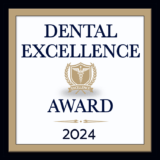
Frequent headaches can be an indicator of a number of conditions, but if your headaches seem to radiate from your temples, you might have a complex, severe, and incredibly common condition known as TMD, or Temporomandibular Joint Disorder. It’s also sometimes incorrectly referred to as TMJ, but that is actually the abbreviation for temporomandibular joint only. Don’t worry, we won’t quibble over an idiom. What’s important is that you understand that there is something you can do to control your symptoms, or even eliminate them! With help from your Joliet IL dentist, you can overcome the pain and misery through TMD treatment.
What is TMD?
Well, we’ll start with TMJ, or the temporomandibular joint. The TMJ (besides being a doozy of a word to type. When we say TMJ in this post, we mean the joint, not the disorder; that’s TMD) is a ball-and-socket joint, which gives it a lot of freedom of movement. The TMJ is responsible for the movement of your jaws, which moves both up and down and side to side. You have a TMJ on both sides of your head, and it connects your jaw to your temporal bones. It’s a fascinating and complex piece of the machine that is your body, and if something goes wrong there, it can create problems in other areas of the body.
Diagnosing TMD
TMD describes the symptoms that are consistent with a dysfunction in the TMJ. This may sound ambiguous, and it is, because the causes of TMD have proved difficult to nail down. While there are known contributors, such as injuries like whiplash, and arthritis may also contribute to the emergence of symptoms. Additionally, TMD is difficult to diagnose, because the symptoms are similar to a number of other problems, both physiological and psychological. Your dentist will need to give you a comprehensive and thorough examination to eliminate these other possibilities.
Symptoms of TMD
This is a fairly lengthy list, and even if you don’t have them all, you should still make an appointment for an examination. Or, at the very least, your dentist will be able to eliminate TMD as a possible source of your pain and discomfort (letting you know that something else might be going wrong elsewhere). Additionally, the “slipperiness” of diagnosing and suggesting TMD treatment is also due to the fact that each person with TMD experiences it differently. There is a lot of variation to account for (in terms of how symptoms present themselves) when you realize that 3 million new cases of TMD are diagnosed every year (in just the US alone)!
If you’re suffering from TMD, you might be experiencing a few or all of these symptoms:
- Severe, frequent headaches that seem to “radiate” from your temples.
- A feeling of tiredness or fatigue in the jaw, or the face.
- Frequent pain in the jaw or face.
- The sensation that your jaws aren’t in proper alignment.
- When you need to “open wide” (as when one yawns or laughs, for example), you find it very difficult, and at times impossible; you may also feel similar discomfort when attempting to close your mouth; some patients have had their jaws lock shut.
- A clicking sound that can be heard by others.
- Swelling of the sides of the face.
- Frequent toothaches, earaches, pain in the upper shoulders or neck.
- Difficulty hearing, or tinnitus (ringing in the ears).
TMD Treatment After Diagnosis
Besides making a reliable diagnosis, your dentist can also provide treatment for your TMD symptoms. Because the causes of TMD are still unknown, the focus of treatment is figuring out how to manage and control of symptoms to the point where they are more or less eliminated, rather than solving the underlying issue.
Because TMD presents itself uniquely from person to person, there is no “cookie cutter” treatment plan. Your treatment may involve only one, or several, interventions and therapies, depending on your symptoms.
Possible Treatments
One of the more common treatments is a custom-designed oral appliance. A custom oral appliance will help “train” your jaw back into proper alignment, and to provide relief from pain. Oral appliances that treat TMD must be custom made. Doing so ensure a precise fit, which is critical for patient comfort while wearing the device and the effectiveness of your treatment. Remember, what good is the appliance doing you if you don’t wear it because it’s uncomfortable?,
Additional therapies might include:
- Prescription pain medications (usually anti-inflammatory pain medications such as Ibuprofen).
- Behavior modification, which can include changes to your diet.
- The performance of regular stretching and movement exercises for your jaw and face.
- Biofeedback has been shown to help some patients as well.
Looking for a Solution for a Never-ending Headache?
Call us and make an appointment for an examination! We can diagnose your problem and provide a specialized treatment plan to help you manage or eliminate your TMD symptoms.
Dial (815) 725-5991 to reach our front desk! Or contact our Shorewood family dentistry. We’re looking forward to meeting you!




